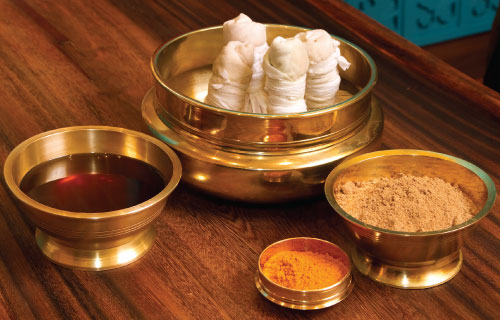Ayurveda (pronounced: are-you-vay-da) is a Sanskrit term. "Ayur" comes from the noun "ayus" meaning life, living or longevity. "Veda" comes from the verb "vid" meaning to know about, to study or science. Thus Ayurveda is commonly translated as science of life or study of longevity. It is the knowledge of what it takes to live a balanced, healthy and inspiring life.
Ayurveda originated in the Indus River Valley (most of which is now West Pakistan).
 Although some associate it with Hinduism or Buddhism, this science of life pre-dates the advent of these religious traditions. Being non-sectarian, it simply comes out of the natural human yearning to live vital, meaningful lives and thus supplements and supports us in the deeper yearnings we have to answer the questions of our place – adding significance to it all.
Although some associate it with Hinduism or Buddhism, this science of life pre-dates the advent of these religious traditions. Being non-sectarian, it simply comes out of the natural human yearning to live vital, meaningful lives and thus supplements and supports us in the deeper yearnings we have to answer the questions of our place – adding significance to it all.
Although it is over 6,000 years old, the humans who lived in that time faced similar challenges that we do today; what to eat, how to adapt to changing environments and circumstances, cope with the many stresses of life that naturally come up as we get older, take on responsibilities, develop relationships, age, and eventually die. Developed over time and finally systematized into a unified body of knowledge, first taught in oral form, then eventually written down about 2,500 years ago, it is a vast amount of information about the promotion of well-being together with warnings about lifestyle habits that can destroy our vitality and happiness.
Since that time, many Ayurvedic texts and commentaries offering a great deal of detailed health information have been written throughout Asia and the Indian subcontinent, the most famous being the Charak Samhita and the Astangha Hridaya – to name just two. Within these and other texts is included information on every stage and facet of life; embryological and pre-natal information, the health concerns of children, men, women, elders and a wide array of therapies that include dietary advice, exercise, hygiene, supplementation, massage, hydrotherapy, surgery and how to work with the mind and emotions.
Although the therapies and daily health recommendations seem similar to the kinds of suggestions one finds today in holistic health circles and preventive magazines, what makes it unique is its systematized way of looking at the body, its constituents and functions. This is not dissimilar from the humoral theories of ancient Greek medicine, but has become refined and updated throughout the ages, making the classifications in Ayurveda inclusive of every imaginable human health concern we see today.
The Ayurvedic system or paradigm of the humors or in Sanskrit, Doshas, is based on the observation of distinct qualities that each body and mind exhibits. Every cell and organ in our body grows, changes, adapts and decays in a very systematized, orderly way. These transformations are grouped in what are called elements, of which there are five. In turn these five elements, space or ether, fire, earth, air and water elements are grouped into the three doshas, a term that actually implies, "that which changes." These three doshas are Vata, associated with our central nervous system, our joints, and thus our ability to move and have things within us (like blood, lymph and air) move and circulate; Pitta, associated with all of our metabolic processes and our circulatory and reproductive systems; and Kapha, associated with the actual mass or physicality of our body.
As is obvious from their description, we all possess vata, pitta and kapha; but for a number of reasons, including our parent's genetics, we posses them in varying degrees. Thus, some of us have bodies and minds that move and change more noticeably, some that are hotter, more intense, are reactive to environment and stimuli, and other bodies are denser in their appearance. Although it would be easy to associate these distinctions like the ectomorph, mesomorph and endomorphic forms of western physiognomy, Ayurveda goes further by identifying deeper and more subtle aspects. At the deepest level, there are spiritual inclinations and emotional tendencies. For in Ayurveda, particularly the Tibetan branch or school of Ayurveda, mind always precedes body. What and how we think has a profound impact on our lifestyle and life.
Thus, knowing one's body/mind type (i.e. how vata, pitta and kapha come together for you), one can come to understand what diet, type of exercise, and even spiritual discipline can be effective in helping us physically, emotionally and spiritually.
 In the spa industry, however, what has gotten the greatest attention are the many bodywork methods that Indian and Tibetan medicine have spawned based on the understanding of what it takes to detox, strengthen and rejuvenate the body.
In the spa industry, however, what has gotten the greatest attention are the many bodywork methods that Indian and Tibetan medicine have spawned based on the understanding of what it takes to detox, strengthen and rejuvenate the body.
Although Ayurvedic treatment modalities include extensive diagnostic techniques and more invasive treatments like surgery and acupuncture, it is the source of so many modalities we see in today's spas: massage techniques such as foot reflexology, polarity therapy and many styles of oleation massage as well as more deep tissue style, aromatherapy, color therapy, gem and stone therapies, music or sound therapy and hydrotherapy. Apply with an Ayurvedic sensibility to the unique body-mind type of the individual and each of these techniques becomes significantly more effective.
Along with these more common therapies, Ayurveda also includes a number of unique, even exotic treatments such as Shirodhara (the profoundly deep and relaxing treatment of pouring of a fine stream of oil onto the forehead), marma chikitsa (the massage of points related to the subtle chakra grid of the body), and the highly effective detoxification regimen known as Pancha Karma (which includes oil massages, hydrotherapy, techniques to cleanse the senses, and the therapeutic application of enemas, emetics and purgatives).
In the mid-90s, when my wife, Melanie Sachs, introduced Ayurveda to the spa and beauty world, she says that there was the feeling that Ayurveda was being viewed as a fad – something that would come and go. But now nearly 20 years later, she sees that the Ayurvedic treatments she introduced at the time and the Ayurvedic sensibility that can be applied to make any treatment more effective is growing – so much so that more and more massage and aesthetic schools wanting to see successful placement for their students include Ayurveda in their curriculum.
Therefore, while Ayurveda may have been most fully developed in the East, the common sense holistic approach of Ayurveda is finding an eager American audience. As Melanie has said, "That which is effective tends to endure and stand the test of time." So Ayurveda, now in its American and spa incarnation, is here to stay.
Want to read more?
Subscribe to one of our monthly plans to continue reading this article.